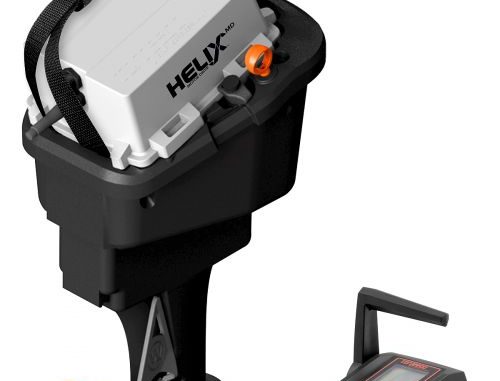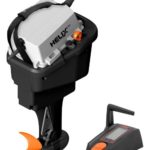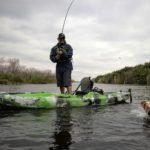
Kayakers can now give paddles a rest
Today’s electric propulsion systems can replace everything from kayak paddles to outboard motors, and fishermen are finding them more proficient than ever.
Bow-mounted fishing motors are about as common as front casting decks on both fresh and saltwater fishing rigs, and extended motor shafts and higher thrust outputs have made them suitable for bigger boats and windier weather.
High-end, electric steering motors from Minn Kota and MotorGuide now have integrated GPS that gives them the ability to steer and follow routes like an autopilot and control motor speed like an automotive cruise control.
The top Minn Kota motors can be networked with select Humminbird multifunction displays, and MotorGuide’s Xi5 Pinpoint GPS models can be controlled by compatible Lowrance units.
The motors can be controlled from the electronics’ keypads or touch screens and can navigate using on-screen maps and charts. Minn Kota’s freshwater Ulterra and saltwater Riptide Ulterra motors even stow and deploy themselves.
Fishing from kayaks has grown in popularity, so makers of these go-anywhere craft are introducing models designed for sport and electric propulsion.
Hobie’s Mirage Pro Angler 17T, for instance, is Lowrance-ready with pre-installed, through-hull cable plug outlets to make installing most electronics easy, and a special trolling motor mounting bracket lets you install a bow-mounted motor and fish the Hobie like you would a bass boat.
Autopilot and cruise control in a kayak? Just add a MotorGuide Xi5 with GPS and a compatible Lowrance fishfinder/chart plotter, and you’ve got it.
Old Town’s 13-foot-2-inch Predator XL Minn Kota model is technically a special-purpose kayak, but it was designed to bridge the gap between fishing kayaks and shallow-water skiffs.
It incorporates a console housing a saltwater-grade Minn Kota motor with 45 pounds of thrust, a battery, sonar mounting plate and a storage compartment. It also features an LED battery charge level indicator and multiple USB charge ports for your personal electronics.
The whole motor console measures 29 inches long by 25 inches high by 12 inches wide and weighs a measly 25.5 pounds (without battery).
A foot-controlled rudder steers the boat in forward or reverse for hands-free operation while you fish.
The basic Predator retails for $1,799, and the Minn Kota motor console adds $1,199.99. You can also go basic and opt for a double-block motor mount accessory ($149.99) and use a transom-mount trolling motor to give your paddle a rest.
Torqeedo manufactures marine electric propulsion systems for kayaks, and small and medium sized boats. Kayaks built by Wilderness Systems are now available with a Helix MD motor drive feature thatputs Torqeedo’s motor technology in a rugged, compact pod engineered to fit in Flex Pod OS-compatible kayaks.
The motor pod drops into a specially designed scupper built into the boat, with its weight well forward of the kayaker and leaving the prop and skeg extending down from the hull’s centerline.
Its lightweight lithium battery (with integrated GPS) can power the motor for eight hours to provide a range of up to 20 miles and speeds up to 6 mph. Torqeedo’s 50W Sunfold panel accessory lets you charge the battery while underway.
The motor is controlled remotely by an intelligent binnacle throttle with an LCD that shows GPS-calculated speed, remaining range and battery run time
The system also works with TorqTrac, an app that displays motor information on Bluetooth LE-equipped smartphones. The Helix Motor Drive pod retails for $1,999.
Torqeedo also offers a transom-mount Ultralight 403 motor ($1,799) rated at 1 horsepower for kayaks, canoes and very light boats. It can run eight hours, 20 minutes at low speed or 48 minutes at full throttle on its integrated lithium battery.
Torqeedo’s Travel series of outboards include the Travel 503 ($1,699.00) rated at 1.5 horsepower and the Travel 1003 ($1,999.00) rated at 3 horsepower.
The travel 503 can run as long as six hours, 20 minutes at slow speed or up to 42 minutes at full throttle. The Travel 1003 can run up to 10 hours, 30 minutes at slow speed and up to 35 minutes at full throttle on a full charge.
The Torqeedo Cruise series of outboards come in 5-, 8- and 20-horsepower models. The two smaller motors come in both tiller and remote steering versions, but the 20 horse motor comes with remote steering only.
The Cruise 2.0 (5 horses) models ($3,798.00 to $3,848.00) can run for up to 10 hours at low speed and an estimated one hour, 15 minutes at full throttle using either one Torqeedo 24-volt battery or two conventional 12-volt lead-acid batteries.
Cruise 4.0 models ($4,298.00 to $4,348.00) compare to an 8-horsepower gas outboard and can run for up to 10 hours, 45 minutes at slow speed or 1 hour, 10 minutes at full throttle. All Cruise models come in short- and long-shaft versions.
The hot new Cruise 10R motor performs like a 20-horsepower gas outboard, and can plane a skiff or rigid inflatable and push it at up to 17 mph. It can operate at slow speeds for up to 8 hours, 20 minutes or at full throttle for 48 minutes.
Torqeedo’s Deep Blue series includes its two largest motors: the Deep Blue 40 and 80 models (both priced at $21,999), which act like 40- and 80-horsepower gas outboards, respectively. They are available in tiller or remote steering versions and come with either long- or extra-long shafts.
The DB 40 can run up to eight hours at slow speed or up to 30 minutes at full throttle powered. The DB 80 can run as long as 16 hours at slow speed or up to 30 minutes at full throttle.
Minn Kota recently introduced a pair of transom-mount electric outboards, the EO ½-horse 12-volt model ($799.99) and the EO 1-horsepower 24-volt model ($899.99).
The motors can run continuously for up to nine hours at half speed on fully charged batteries. They feature push-to-test battery state of charge meters.
Minn Kota continues to offer its 48-volt E-Drive 2 horsepwer primary propulsion system ($2,999.99) for conventional hulls and pontoon boats.
The E-Drive uses a bolt-on transom mount, and comes with an electronic binnacle throttle control with a push-button trim/tilt feature, a real-time display with a “fuel gauge” showing the power remaining in the batteries, the remaining motor run time and the current throttle power level setting. A trim gauge is optional.
E-Drives use a stainless steel prop with a special shear pin and a replaceable, hub-mounted zinc anode to fight galvanic corrosion.




